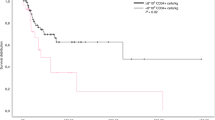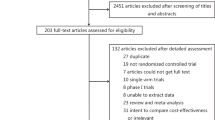Abstract
The combination of mitozantrone, methotrexate and mitomycin (3M) gives a response rate of around 50% in patients with advanced breast cancer. The predominant toxicity is haematological. In this study, previously untreated patients were given 3M with increasing doses of mitozantrone (7-14 mg m-2) with recombinant human granulocyte colony-stimulating factor (metHuG-CSF) (filgrastim) to prevent marrow toxicity. Doses administered were 7 mg m-2 mitomycin i.v. 6 weekly, methotrexate i.v. 35 mg m-2 (maximum 50 mg) 3 weekly and mitozantrone i.v. 3 weekly as follows: 7 mg m-2, six patients (group 1); 10 mg m-2, six patients (group 2); 12 mg m-2, six patients (group 3); 14 mg m-2, six patients (group 4); all on day 1 for six cycles at the assigned dose. All patients received filgrastim (Amgen 0.3 mg ml-1) at a dose of 5 micrograms kg-1 subcutaneously daily on days 4-17 of each cycle. All treatment was given on an out-patient basis. A total of 24 patients were entered into the study. The median age was 63 years (range 48-75). ECOG performance status was 0 in ten, 1 in 11 patients and 2 in three patients. Locoregional disease alone was present in seven patients. The remainder had one or more sites of metastases. The actual dose administered to the 24 patients was as follows. The six patients in group 1 all completed six courses of treatment as per protocol. In group 2, three patients completed six courses, two stopped because of toxicity after one and four courses and one had progressive disease after one course. In group 3, three patients completed and three stopped early because of progressive disease. In group 4, two patients completed, one progressed after four courses and three responding patients stopped treatment because of toxicity. The maximum tolerated dose of mitozantrone in the 3M combination was 12 mg m-2. The use of filgrastim with increasing doses of chemotherapy prevents neutropenia, but other toxicities, namely thrombocytopenia and lethargy, then become dose limiting.
This is a preview of subscription content, access via your institution
Access options
Subscribe to this journal
Receive 24 print issues and online access
$259.00 per year
only $10.79 per issue
Buy this article
- Purchase on Springer Link
- Instant access to full article PDF
Prices may be subject to local taxes which are calculated during checkout
Similar content being viewed by others
Author information
Authors and Affiliations
Rights and permissions
About this article
Cite this article
O'Brien, M., Nicolson, M., Montes, A. et al. Phase I study of mitozantrone, methotrexate and mitomycin with granulocyte colony-stimulating factor (filgrastim) in patients with advanced breast cancer. Br J Cancer 70, 980–983 (1994). https://doi.org/10.1038/bjc.1994.433
Issue Date:
DOI: https://doi.org/10.1038/bjc.1994.433



